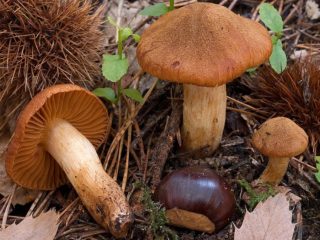Content
Cobwebs are a genus of basidiomycetes belonging to the Agarikov class; they are popularly called marsh plants. Light ocher webweed is a lamellar mushroom, a representative of this genus. In the scientific literature its Latin name is found - Cortinarius claricolor.
Description of the light ocher web spider
This is a dense, strong, small mushroom. In the forest it can be found growing in large families.

Single specimens are rare
Description of the cap
Young mushrooms have a round, smooth, slimy cap, the edges are curved down, its diameter does not exceed 5 cm. The color of the outer surface is light brown or dark beige.Old, overripe fruiting bodies have a prostrate, almost flat, dry, wrinkled cap; its diameter can reach up to 15 cm.

From below on the surface of the cap of young light-buff webworts you can observe a light thin film in the form of a veil that hides the plates
As the cap grows and opens, such a web bursts; in overripe specimens, its remains are visible only at the edges. Because of this feature, the basidiomycete was called the cobweb.
In young mushrooms, the plates are frequent, narrow, light, mostly white; over time they darken and become dirty beige.
Description of the leg
The leg of the light ocher webwort is long, fleshy, almost smooth, and may widen slightly towards the bottom. The length does not exceed 15 cm, the diameter is 2.5 cm. Its color is dirty white or light gray.

The inside of the leg is not hollow, fleshy, juicy, uniformly white
The remains of the bedspread are located across its entire surface. The smell is pleasant, mushroom, the taste is not pronounced, the cut areas do not darken. Wormholes are rare, as insects do not like to feast on cobwebs.
Where and how does it grow
Light buffy spiderwort is found in the temperate climate of Europe, in mountainous areas. In Russia, this is the European part (Leningrad region), also Siberia, Karelia, Murmansk region, Krasnoyarsk region, Buryatia.
A representative of the Agariaceae family grows in dry coniferous forests and open meadows. Most often found in moss thickets. The light ocher spiderwort grows in large families; it is rarer to find single specimens. Mushroom pickers testify that it can form so-called “witch circles” of 40 fruiting bodies each.
Is the mushroom edible or not?
In the scientific literature, basidiomycetes are classified as inedible, mildly poisonous mushrooms. Some lovers of quiet hunting claim that after prolonged heat treatment, the fruiting bodies of the light ocher cobweb are edible. And yet, they are not recommended for consumption in any form.
Doubles and their differences
The young light buffy spiderwort is similar to the porcini mushroom (boletus) - an edible, valuable basidiomycete with high taste. There are practically no external differences between them. Upon closer examination, it turns out that the hymenophore of the boletus is tubular, while in the cobweb it is formed in the form of plates.

The young porcini mushroom is more fleshy and stocky, its cap is matte, velvety, dry
Another double is the late webweed. Latin name – Cortinarius turmalis. Both species are representatives of the Pautinnikov family. The double has a brighter cap, its color is dark orange or brown. This representative of the species grows in deciduous forests and is inedible.

The cap of the late gossamer is more spread out than that of the light buff, even at a young age
Conclusion
Light ocher spiderwort is a mushroom that is often found in the coniferous forests of Russia, Europe, and the Caucasus. Young specimens can be confused with valuable boletus mushrooms. It is important to study their differences well. In the later period of ripening, the marsh grass takes on a form unique to it. The fruit body of the described species has no nutritional value and, according to some sources, is poisonous. It is not recommended to collect and eat this representative of the Spider web family. This may be hazardous to your health.








